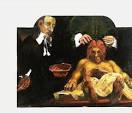I make it a rule in life to give the medicos a wide berth. Get into their hands and you are on a conveyor belt that leads to either drug consumption for the rest of your mortal or lying on the operating table or both.
Of course, having an operation is not as traumatic as it was a couple of centuries ago when surgeons were rightly known as saw bones and the poor patient was literally biting the bullet to endure the pain. We like to think that the anaesthetist with their bag of drugs are sufficiently skilled to administer sufficient knockout drops to see us through our procedure.
I hold no truck with these local anaesthetic procedures. I don’t want to see my giblets rearranged, thank you very much, and I have no desire to see the inner workings of my body. There is a very good reason why it is encased in skin and my eyes point outwards! If there is any procedures or surgery required then I want to be out like a light. There is something quite pleasant about the rapidity in which you lose consciousness, the profundity of your unconsciousness and the delight to be had in coming round.
Alas, my confidence in anaesthetics or, perhaps, the proficiency of those administering them has taken a bit of a knock when I read a synopsis of a study conducted by the Royal College of Anaesthetics – reading the whole report would, I fear, have done the job of a mild anaesthetic. The report has found that at least 150 and, possibly, as many as several thousand of us a year are conscious whilst undergoing surgery. The reason for the wide range in the estimates is that people are often reluctant to speak of their operating table experiences.
A common thread seems to be that the patients have been given a muscle-relaxing drug as well as an anaesthetic – the relaxant paralyses the patient making it difficult for operating staff to see that they are conscious. Around 10% of the cases were caused by drug errors. In some cases, patients had been given relaxants but not anaesthetics, meaning they were conscious throughout the whole procedure. The period of maximum danger is either at the start or the end of an operation. This phenomenon is most common during a caesarean or a heart procedure.
Not unsurprisingly, half of the victims were distressed by the experience and 41%, perhaps sensing a bit of compo on the horizon, claimed they had suffered long-term psychological harm. The sensations they felt included tugging, stitching, pain and choking and they reported feelings of dissociation, panic and a sense of entombment.
On the other hand, the blissed out section of the survey took comfort in the sense of detachment they felt from the whole process.
I suppose you pays your money and takes your choice. For me, though, I will continue to give the people in white coats a swerve.







